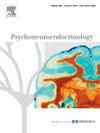中年人的邻里劣势和CD14基因表达升高:来自美国中年人研究的发现
IF 3.4
2区 医学
Q2 ENDOCRINOLOGY & METABOLISM
引用次数: 0
摘要
社会和环境因素对健康至关重要,部分原因是免疫系统编程在慢性病发病前几十年就开始了。本研究量化了邻里机会与CD14基因表达之间的关系,CD14基因表达是循环白细胞池中单核细胞丰度和炎症潜能的关键标志。邻里机会是用儿童机会指数3.0来衡量的,它反映了整体邻里机会和三个子领域(教育、健康和环境、社会和经济资源)。来自美国中年研究的1215名中年人(57 ± 12岁)的多变量线性回归分析显示,即使在调整了关键的社会人口学特征和健康行为之后,居住在弱势社区的个体的CD14基因表达水平也比生活在高机会社区的个体高36.6% %(95 % CI: 11.7-65.9 %升高,p = 0.002)。教育领域(27.5 %升高,95 % CI: 5.0-54.8 %升高,p = 0.015)和社会&;经济资源域(32.9 %升高,95 % CI: 8.7-62.5 %升高,p = 0.006)与CD14基因表达水平升高密切相关。这些发现扩展了先前的研究,表明社会因素如何通过交感神经系统激活和改变骨髓生成而“深入皮肤”,产生促炎、抗糖皮质激素的免疫表型。本文章由计算机程序翻译,如有差异,请以英文原文为准。
Neighborhood disadvantage and elevated CD14 gene expression among middle-aged adults: Findings from the Midlife in the United States study
Social and environmental factors are crucial in health, partly through immune system programming that begins decades before chronic disease onset. This study quantified the associations between neighborhood opportunity and CD14 gene expression, a key marker of monocyte abundance and inflammatory potential in the circulating leukocyte pool. Neighborhood opportunity was measured using the Childhood Opportunity Index 3.0 reflecting Overall Neighborhood Opportunity and three subdomains (Education, Health and Environment, and Social and Economic Resources). Multivariable linear regression analyses among 1215 middle-aged adults (57 ± 12 years) from the Midlife in the United States Study revealed that individuals residing in disadvantaged neighborhoods had 36.6 % (95 % CI: 11.7–65.9 % elevation, p = 0.002) higher CD14 gene expression levels than those in neighborhoods with high opportunity, even after adjusting for key sociodemographic characteristics and health behaviors. The Education domain (27.5 % elevation, 95 % CI: 5.0–54.8 % elevation, p = 0.015) and Social & Economic Resources domain (32.9 % elevation, 95 % CI: 8.7–62.5 % elevation, p = 0.006) strongly tracked with elevated CD14 gene expression levels. These findings extend previous research showing how social factors “get under the skin” through sympathetic nervous system activation and altered myelopoiesis, producing a proinflammatory, glucocorticoid-resistant immune phenotype.
求助全文
通过发布文献求助,成功后即可免费获取论文全文。
去求助
来源期刊

Psychoneuroendocrinology
医学-精神病学
CiteScore
7.40
自引率
8.10%
发文量
268
审稿时长
66 days
期刊介绍:
Psychoneuroendocrinology publishes papers dealing with the interrelated disciplines of psychology, neurobiology, endocrinology, immunology, neurology, and psychiatry, with an emphasis on multidisciplinary studies aiming at integrating these disciplines in terms of either basic research or clinical implications. One of the main goals is to understand how a variety of psychobiological factors interact in the expression of the stress response as it relates to the development and/or maintenance of neuropsychiatric illnesses.
 求助内容:
求助内容: 应助结果提醒方式:
应助结果提醒方式:


